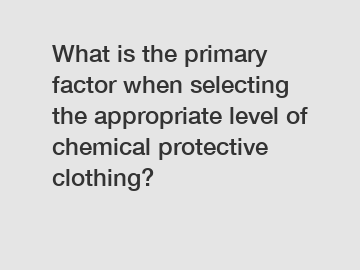What is the primary factor when selecting the appropriate level of chemical protective clothing?
When selecting the appropriate level of chemical protective clothing, the primary factor to consider is the type of chemical or hazard that the clothing will be protecting against.
Step 1: Identify the Hazard.
The first step in selecting the appropriate level of chemical protective clothing is to identify the specific chemical or hazard that workers will be exposed to. This may include corrosive chemicals, toxic substances, biological materials, or radioactive materials. Different chemicals and hazards require different levels of protection, so it is essential to understand the nature of the hazard before selecting the appropriate clothing.

Step 2: Consult Safety Data Sheets (SDS).
Once the hazard has been identified, consult the Safety Data Sheets (SDS) for the chemicals involved. The SDS will provide important information about the properties of the chemical, including its toxicity, flammability, and reactivity. This information will help determine the level of protection required for workers who will be handling the chemical.
Step 3: Determine the Level of Protection Needed.
Based on the hazard identification and information from the SDS, determine the level of protection needed for workers. Chemical protective clothing is categorized into different levels based on the level of protection they provide. These levels range from Level A, which offers the highest level of protection, to Level D, which offers minimal protection.
Step 4: Select the Appropriate Clothing.
Once the level of protection needed has been determined, select the appropriate chemical protective clothing. Different types of protective clothing include coveralls, gloves, boots, face shields, and respirators. Ensure that the clothing selected meets the requirements for the specific hazard and provides the necessary level of protection.
Step 5: Provide Training and Maintenance.
Finally, provide training to workers on the proper use and maintenance of the chemical protective clothing. Workers should understand how to properly put on and remove the clothing, as well as how to inspect and care for it. Regular maintenance and inspection of the clothing is essential to ensure that it continues to provide adequate protection.
In conclusion, when selecting the appropriate level of chemical protective clothing, the primary factor to consider is the type of chemical or hazard that the clothing will be protecting against. By following these steps and carefully assessing the specific hazard, employers can ensure that workers are adequately protected from exposure to hazardous materials.
Contact us to discuss your requirements of types of surgical packs, acid resistant chemical protective coverall, SMS lamiantion. Our experienced sales team can help you identify the options that best suit your needs.
173
0
0


Comments
All Comments (0)